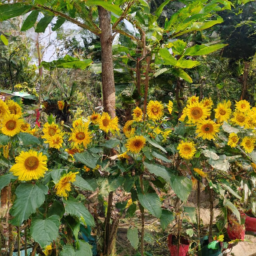Backyard Sunflower Garden Ideas
Backyard Sunflower Garden Ideas
Backyard Sunflower Garden Ideas
Planting Sunflowers in Your Home Garden: What to Know
A sunflower garden can add beauty, vibrancy, and even a taste of nature's bounty to any home garden. Sunflowers offer a multitude of benefits from attracting pollinators to providing abundant amounts of edible seed. Though backyard sunflower gardens may take up large portions of yard space, these magnificent plants are well worth the effort. Before planting your sunflower garden there are some key points to consider.
Size of Sunflower Varieties
When it comes to planting sunflowers the size of the variety is of key importance. Not all sunflower varieties reach the same infamously tall stature of a traditional sunflower. Some heirloom varieties may reach heights as short as 3 feet, while others may tower as high as 10 feet. Consider the size of the sunflower, as well as the layout of the garden when it comes to choosing a local variety.
Soil Preparation
Soil preparation is essential when it comes to planting sunflowers. To prepare the soil for planting dig into the top layers to a depth of 8 to 10 inches. Mix in 5-6 inches of compost and a 10-10-10 fertilizer into the topsoil. Sunflowers prefer a soil pH of 6.0-7.5. Ensure to purchase a soil testing kit to determine the acidity of the soil.
Timing of Plantings
Timing of plantings is essential when it comes to ensuring a successful backyard sunflower harvest. According to The Old Farmer's Almanac, in most regions planting should occur in late April to early June so that sunflowers will be harvested in late summer and early fall. Make sure to consult local growing guides to ensure an appropriate time frame for planting.
Attracting Pollinators to the Garden
Attracting pollinators to a home sunflower garden is essential for successful growth of the blooms. Unfortunately many of the same insects that feed on sunflower nectar are also destructive to plants such as aphids and thrips. To attract beneficial pollinators and deter pests plant sunflower companion flowers such as tall phlox, cosmos, and daisies nearby.
Harvesting Sunflowers
Once the back garden sunflowers begin to bloom preparing for the harvest will become an easy task. Sunflower plants are ready to be harvested begun once the back of the sunflower head turns yellow and the center of the sunflower has turned a deep brown. Carefully cut off the stem a few inches from the flower head and hang the flower heads upside down in a cool, ventilated area. The heads should dry out in about two weeks. When the heads have completely dried out remove the seeds by rubbing the backs of the petals together.
Sunflower Hulling and Roasting
Hand Hulling
Once the sunflower seeds have been removed from the petals, hand hulling is a great way to remove the final edible seed from the hull without the use of a machine. Using two pieces of mesh screen with openings large enough for the seed to fit through, press the seeds through the screen. The seeds will pass through the first screen while the hulls will be held back.
Roasting Sunflower Seeds
Once the sunflower seeds and been hulled and cleaned they are ready to be roasted. Place the seeds in a pan on the stove top over medium-high heat. Stir the seeds in the pan for 6-7 minutes or until they are lightly browned. Season the seeds with favorite spices or simply a touch of sea salt.
Closing Remarks
Having a backyard sunflower garden can be an incredibly rewarding experience. From the eye-catching blooms to the delicious harvest that follows. With a bit of preparation and observing the ever-important timing of planting, anyone can reap the reward of a thriving sunflower garden.
For additional sunflower resources we recommend visiting the Fairview Garden Learning Center for a wealth of information about planting and caring for sunflower plants in the home garden.

Previous Page
